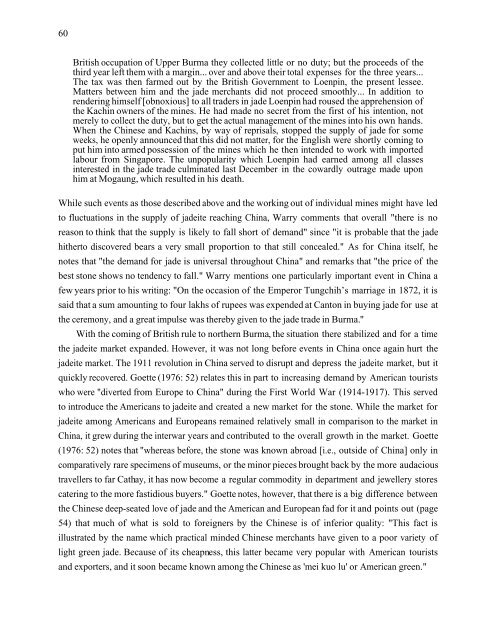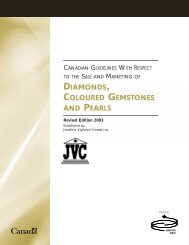JADEITE - Canadian Institute of Gemmology
JADEITE - Canadian Institute of Gemmology
JADEITE - Canadian Institute of Gemmology
You also want an ePaper? Increase the reach of your titles
YUMPU automatically turns print PDFs into web optimized ePapers that Google loves.
60<br />
British occupation <strong>of</strong> Upper Burma they collected little or no duty; but the proceeds <strong>of</strong> the<br />
third year left them with a margin... over and above their total expenses for the three years...<br />
The tax was then farmed out by the British Government to Loenpin, the present lessee.<br />
Matters between him and the jade merchants did not proceed smoothly... In addition to<br />
rendering himself [obnoxious] to all traders in jade Loenpin had roused the apprehension <strong>of</strong><br />
the Kachin owners <strong>of</strong> the mines. He had made no secret from the first <strong>of</strong> his intention, not<br />
merely to collect the duty, but to get the actual management <strong>of</strong> the mines into his own hands.<br />
When the Chinese and Kachins, by way <strong>of</strong> reprisals, stopped the supply <strong>of</strong> jade for some<br />
weeks, he openly announced that this did not matter, for the English were shortly coming to<br />
put him into armed possession <strong>of</strong> the mines which he then intended to work with imported<br />
labour from Singapore. The unpopularity which Loenpin had earned among all classes<br />
interested in the jade trade culminated last December in the cowardly outrage made upon<br />
him at Mogaung, which resulted in his death.<br />
While such events as those described above and the working out <strong>of</strong> individual mines might have led<br />
to fluctuations in the supply <strong>of</strong> jadeite reaching China, Warry comments that overall "there is no<br />
reason to think that the supply is likely to fall short <strong>of</strong> demand" since "it is probable that the jade<br />
hitherto discovered bears a very small proportion to that still concealed." As for China itself, he<br />
notes that "the demand for jade is universal throughout China" and remarks that "the price <strong>of</strong> the<br />
best stone shows no tendency to fall." Warry mentions one particularly important event in China a<br />
few years prior to his writing: "On the occasion <strong>of</strong> the Emperor Tungchih’s marriage in 1872, it is<br />
said that a sum amounting to four lakhs <strong>of</strong> rupees was expended at Canton in buying jade for use at<br />
the ceremony, and a great impulse was thereby given to the jade trade in Burma."<br />
With the coming <strong>of</strong> British rule to northern Burma, the situation there stabilized and for a time<br />
the jadeite market expanded. However, it was not long before events in China once again hurt the<br />
jadeite market. The 1911 revolution in China served to disrupt and depress the jadeite market, but it<br />
quickly recovered. Goette (1976: 52) relates this in part to increasing demand by American tourists<br />
who were "diverted from Europe to China" during the First World War (1914-1917). This served<br />
to introduce the Americans to jadeite and created a new market for the stone. While the market for<br />
jadeite among Americans and Europeans remained relatively small in comparison to the market in<br />
China, it grew during the interwar years and contributed to the overall growth in the market. Goette<br />
(1976: 52) notes that "whereas before, the stone was known abroad [i.e., outside <strong>of</strong> China] only in<br />
comparatively rare specimens <strong>of</strong> museums, or the minor pieces brought back by the more audacious<br />
travellers to far Cathay, it has now become a regular commodity in department and jewellery stores<br />
catering to the more fastidious buyers." Goette notes, however, that there is a big difference between<br />
the Chinese deep-seated love <strong>of</strong> jade and the American and European fad for it and points out (page<br />
54) that much <strong>of</strong> what is sold to foreigners by the Chinese is <strong>of</strong> inferior quality: "This fact is<br />
illustrated by the name which practical minded Chinese merchants have given to a poor variety <strong>of</strong><br />
light green jade. Because <strong>of</strong> its cheapness, this latter became very popular with American tourists<br />
and exporters, and it soon became known among the Chinese as 'mei kuo lu' or American green."









